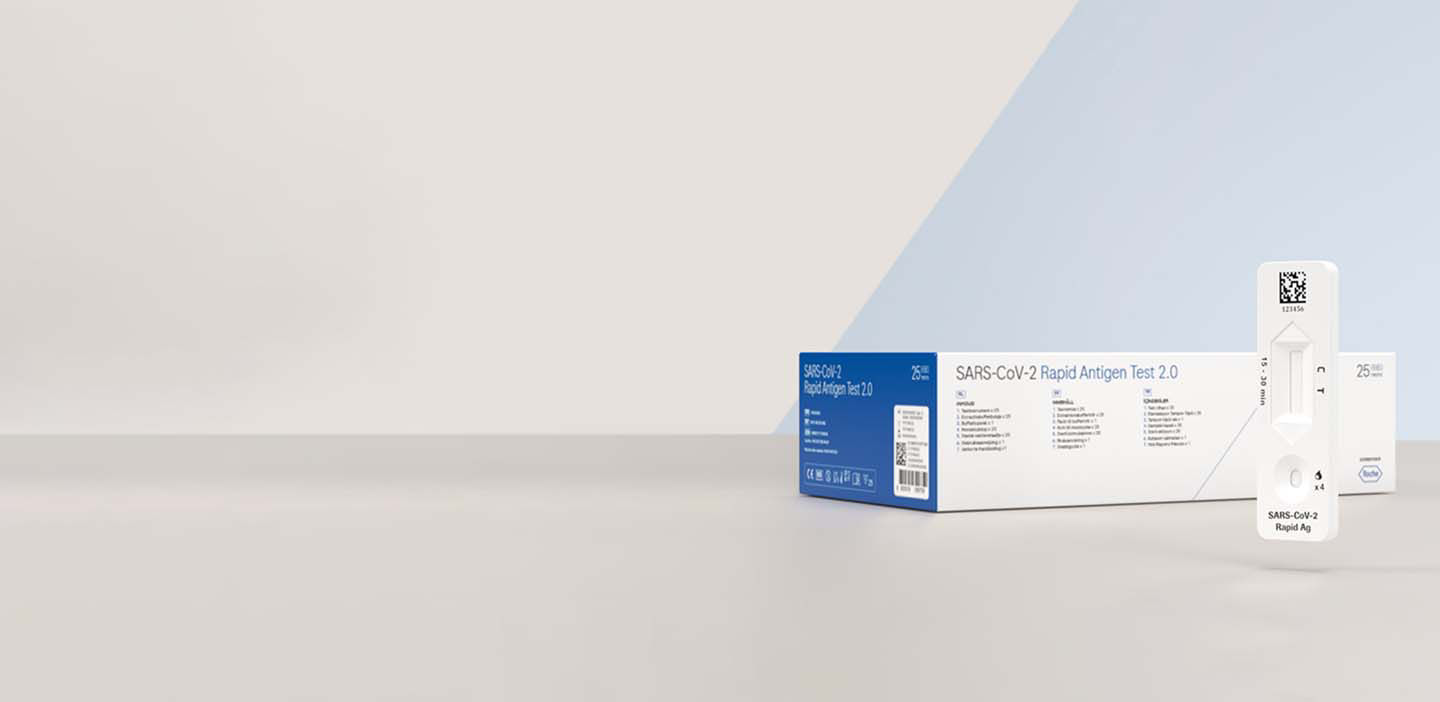SARS-CoV-2 Rapid Antigen Test 2.0

Key features
- Enhanced performance compared to previous version: 99.00% relative sensitivity and 99.75% relative specificity1
- Detection of SARS-CoV-2 infection in symptomatic and asymptomatic individuals1
- Optimized composition to detect antigens against several dominant variants of the virus1
- No instrument required
- Enables access to testing in areas where laboratory testing is not available
- Rapid answers in only 15 minutes
- Data matrix code on each test device for facilitated result sharing
Performing a test
Simple to perform and fast results within 15–30 min*

Collection of nasopharyngeal sample
Tilt the patient’s head back slightly (approximately at a 70° angle). Insert a sterile swab into the nostril of the patient, reaching the surface of the posterior nasopharynx. Rotate the swab 3-4 times against the nasopharyngeal surface.

Sample preparation
Insert the swab into an extraction buffer tube. While squeezing the buffer tube, stir the swab at least 10 times. Remove the swab while squeezing the sides of the tube to extract the liquid from the swab. Press the nozzle cap tightly onto the tube.

Performing a test
Apply 4 drops of extracted specimen to the specimen well of the test device.
WARNING!
Dispense the specimen at 90 degree angle to allow for free-falling drops drops and avoid bubbles.

Read the results
Read the test at 15 to 30 minutes.
WARNING!
Test results that are read before 15 minutes or after 30 minutes may be incorrect.
WARNING!
Failure to squeeze the tube can lead to incorrect results.
*Before using the SARS-CoV-2 Rapid Antigen Test 2.0, carefully read the Instructions for Use and all included warnings and precautions.
Result interpretation
Test results are quick and easy to read

Positive test result
If both colored lines C and T are visible, even if they are faint or not uniform, the test result is positive. This means the test detected the virus protein in the sample. The tested person is very likely infected with SARS-CoV-2.
Control line C: Indicates that the test is working correctly
Test line T: Visibile if SARS-CoV-2 antigen was detected

Negative test result
A visible control line C alone means the test worked correctly. The test result is negative. No virus protein could be detected in the sample. The tested person is unlikely infected with SARS-CoV-2.

Invalid test result
If a control line (C) is not visible, or only the line marked with a T, the result must be considered invalid. The test is not working correctly and you should perform another test using a different test kit.
Test kit information
Each kit contains 25 individually packaged, ready-to-use tests.
The following components are needed for a test and included in the kit:
- Test device (individually in a foil pouch with desiccant)
- Extraction buffer tube and buffer tube rack
- Nozzle cap
- Sterile swab
- Instructions For Use and Quick Reference Guide

Digital connectivity
The SARS-CoV-2 Rapid Antigen Test 2.0 is equipped with a 2D data matrix code and a unique identifier printed on each test cassette. The 2D code is compliant with the common industry standard GS1 and thus can be read and interpreted by any IT system compatible with standard 2D data matrix codes.
Data matrix code
The 2D cata matrix code is unique to each test device. The following elements are encoded in a digitally readable format:
- Lot number
- Expiry date
- GTIN (Global Trade Item Number)
- Reference to source entity (i.e. production factory identification)
- Serial number (i.e. 6-digit ID printed on the test cassette - unique per lot range)

The unique identification of each test device enables a one to one assignment of test results to individual persons. This facilitates storage of test results under the respective patient ID in Electronic Medical Records. A digital readout of the data matrix code can lead to more efficient processes, especially in testing environments
with a high throughput.
References
- Roche Diagnostics. SARS-CoV-2 Rapid Antigen Test 2.0, Package Insert 2022-05, V1.0; Relative sensitivity and relative specificity are compared to RT-PCR.
*Relative sensitivity and relative specificity are compared to RT-PCR.

